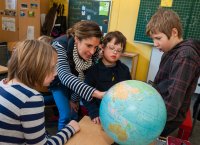Meeting the Challenge of Twice Exceptional Students
Gifted students who also have disabilities can slip through the cracks of the education system, prompting some states and districts to formulate new policies.
Your content has been saved!
Go to My Saved Content.Students who are identified as exceptionally bright but also have disabilities need specialized attention, reporter Rachel Blustain explains in The Hechinger Report. While some may see these twice exceptional students as a rarity, students who are gifted now make up six percent of the population of students with disabilities—so schools across the country are grappling with how to address their needs.
These twice exceptional, or 2e, students “possess high academic aptitude but struggle with ADHD, mild autism, dyslexia or other learning and behavioral challenges,” writes Blustain, and are often underserved, in large part because it is a challenge to identify them. Disabilities are determined under the Individuals with Disabilities Education Act which requires assistance for students with conditions that “adversely affect educational performance.” Some 2e students, though, may slip through the system unnoticed because their outstanding performance in some subjects masks other issues. Students may have high math abilities, for example, but lack competence in social and emotional skills, or they may excel in verbal proficiency but struggle with executive function.
In her book, Differently Wired, parent Debbie Reber writes that because children who are neurodiverse like her son, “can often ‘pass’ as ‘typical kids,’ it’s not always easy for teachers, other parents, and sometimes even our own families to recognize or respect the challenges” they face.
The characteristics of a twice-exceptional child may not be readily apparent to educators unless they look beyond traditional assessment techniques. “Teachers need to be able to recognize when students aren’t reaching their potential even though they may be passing their classes” said Debbie Carroll, co-chair of the subcommittee on Twice Exceptional Advocacy of the Council of Parent Attorneys and Advocates. “They need to understand that smart kids with behavioral problems may not just be willful or lazy, but may in fact need support.”
To that end, some states, like New York, are introducing laws to require training for staff who work with twice exceptional students and implementation of specific programs to address 2e students’ needs, Blustain writes. Teachers in Montgomery County, Maryland, receive tailored instruction on how to identify and address the needs of 2e students. While the goal is to mainstream all students by 6th grade, Montgomery County may also be “the only school district to offer self-contained classes for students in elementary school who need both an accelerated curriculum and more support than they would receive in a mainstream classroom.”
Sarah Jackson, an instructional coach for 2e needs in the county, works to prepare teachers with support in special education classes, as well as programming for student work on self-advocacy and executive function, Blustain writes. Individualized attention is important, so districts have to consider how to provide services adapted to address the needs of 2e students. For students who are gifted in a particular area of study, that may mean taking advanced coursework in that subject while remaining with their peers in others.
